Layout Design and Die Casting Using CAE Simulation for Household Appliances
Abstract
:1. Introduction
2. CAE Simulation of Die-Casting Process
2.1. Numerical Model of Die-Casting Process
2.2. Geometry Model of CAE Simulation
2.3. Condition of CAE Simulation
3. Results and Discussion
3.1. Flow Analysis of CAE Simulation
3.1.1. Flow Analysis of CASE 1
3.1.2. Flow Analysis of Case 2
3.2. Solidification Analysis of CAE Simulation
4. Improvements of the Casting Layout
5. Conclusions
- (1)
- According to the flow analysis results, the location of air isolation and the direction of filling of the molten flow was adequately determined. In addition, the shape of the most appropriate in-gate was appropriately identified according to the several casting layouts. It was determined that the results can be used to properly eliminate various problems caused by an imbalance in the melt flow.
- (2)
- According to the flow analysis results, the melt flow in the final casting, layout 3, was the most uniform than compared to casting layouts 1 and 2. Solidification analysis of the final casting layout also identified microshrinkage during the solidification process. It is believed that securing adequate cooling locations in the mold development process will significantly reduce trial and error of different types and shorten the mold development period.
- (3)
- According to the flow analysis results, the reflux phenomenon caused by backflow during filling was initially predicted, and a method was found to equalize the melt flow. Applying these results can reduce the reflux phenomenon when filling, and save time and expense of casting post-processing.
Funding
Institutional Review Board Statement
Informed Consent Statement
Conflicts of Interest
References
- Hu, B.; Tong, K.; Niu, X.; Pinwill, I. Design and optimisation of runner and gating systems for the die casting of thin-walled magnesium telecommunication parts through numerical simulation. J. Mater. Process. Technol. 2000, 105, 128–133. [Google Scholar] [CrossRef]
- Park, J.-Y.; Kim, E.-S.; Park, Y.-H.; Park, I.-M. Optimization of Casting design for automobile transmission gear housing by 3D filling and solidification simulation in local squeeze diecasting process. Korean J. Mater. Res. 2006, 16, 668–675. [Google Scholar] [CrossRef] [Green Version]
- Kim, E.; Park, J.; Jeon, E.; Park, I. Current state and technology trend of domestic diecasting industry for automotive parts. J. Korea Foundry Soc. 2007, 27, 13–19. [Google Scholar]
- Jeong, B.-G.; Kwon, H.-K. A case study on developing automotive part (housing) by filling and solidification analysis. J. Soc. Korea Ind. Syst. Eng. 2015, 38, 44–51. [Google Scholar] [CrossRef]
- Cho, G.-S.; Choe, K.-H. Study on the rationalization of aluminium casting alloys for automobiles components. J. Korea Foundry Soc. 2011, 31, 319–325. [Google Scholar] [CrossRef]
- Jeong, W.; Yoon, H.; Hong, S.; Park, I. Optimal gating system design of escalator step die casting part by using Taguchi method. J. Korea Foundry Soc. 2000, 20, 97–103. [Google Scholar]
- Fu, M.; Yong, M. Simulation-enabled casting product defect prediction in die casting process. Int. J. Prod. Res. 2009, 47, 5203–5216. [Google Scholar] [CrossRef]
- Jeon, E.; Park, J.; Park, I. Application trend of aluminum castings in automotive component. J. Korea Foundry Soc. 2007, 27, 20–23. [Google Scholar]
- Lee, D.; Kang, C.; Lee, S. Prediction defect of automotive components by filling and solidification analysis. J. Korea Foundry Soc. 2000, 20, 159–166. [Google Scholar]
- Kim, Y.; Choi, S.; Cho, J.; Jeong, C.; Kang, C. Optimization of thin-walled aluminum die casting design by solidification simulation. J. Korea Foundry Soc. 2008, 28, 190–194. [Google Scholar]
- Jin, C.-K.; Kang, C.-G. Fabrication process of aluminum bipolar plate for fuel cell using vacuum die casting. J. Korea Foundry Soc. 2011, 31, 71–78. [Google Scholar] [CrossRef] [Green Version]
- Gramegna, N.; Della Corte, E.; Poles, S. Manufacturing process simulation for product design chain optimization. Mater. Manuf. Process. 2011, 26, 527–533. [Google Scholar] [CrossRef]
- Park, J.; Kim, E.; Park, I. Die casting process design of automobile gear housing by metal flow and solidification simulation. J. Korea Foundry Soc. 2004, 24, 347–355. [Google Scholar]
- Zhang, L.; Li, L.; Zhu, B. Simulation study on the LPDC process for thin-walled aluminum alloy casting. Mater. Manuf. Process. 2009, 24, 1349–1353. [Google Scholar] [CrossRef]
- Wu, S.; Fuh, J.; Lee, K. Semi-automated parametric design of gating systems for die-casting die. Comput. Ind. Eng. 2007, 53, 222–232. [Google Scholar] [CrossRef]
- AnyCasting. User Manual Version 6.5; AnyCasting Software: Seoul, Korea, 2019; pp. 55–62. [Google Scholar]
- Kwon, H.; Kwon, H. Computer aided engineering (CAE) simulation for the design optimization of gate system on high pressure die casting (HPDC) process. Robot. Comput. Integr. Manuf. 2019, 55, 147–153. [Google Scholar] [CrossRef]
- Kim, T.G.; Choi, J.K.; Hong, J.P.; Lee, Z.H. Reduction of computing time through FDM using implicit method and latent heat treatment in solidification analysis. J. Korea Foundry Soc. 1993, 13, 323–332. [Google Scholar]
- Xun, S.; Junqing, W.; Hwang, H.Y.; Choi, J.K. Numerical simulation of mold filling process of castings by using of predictor-two step Corrector-VOF. J. Korea Foundry Soc. 2002, 22, 299–303. [Google Scholar]
- Lee, Y.C.; Choi, J.K.; Hong, C.P. Development of an Integrated Simulation System and its Application to Casting Design. J. Korea Foundry Soc. 1997, 17, 552–559. [Google Scholar]
- Kwon, H.Y.; Yoon, T.H.; Lee, B.J. Computer simulation on the High-Pressure Die Casting (HDPC) process by filling and solidification analysis. Int. J. Appl. Eng. Res. 2015, 10, 142–145. [Google Scholar] [CrossRef]
- Jin, C.-K.; Jang, C.-H.; Kang, C.-G. Vacuum die casting mold design of fuel cell bipolar plate using die filling simulation and experimental verification. J. Korea Foundry Soc. 2012, 32, 65–74. [Google Scholar] [CrossRef] [Green Version]
- Hosseini, S.M.; Utlu, Z. Design optimization of clutch housing mold by fluid flow and solidification simulation. J. Mech. Sci. Technol. 2016, 30, 2731–2742. [Google Scholar] [CrossRef]
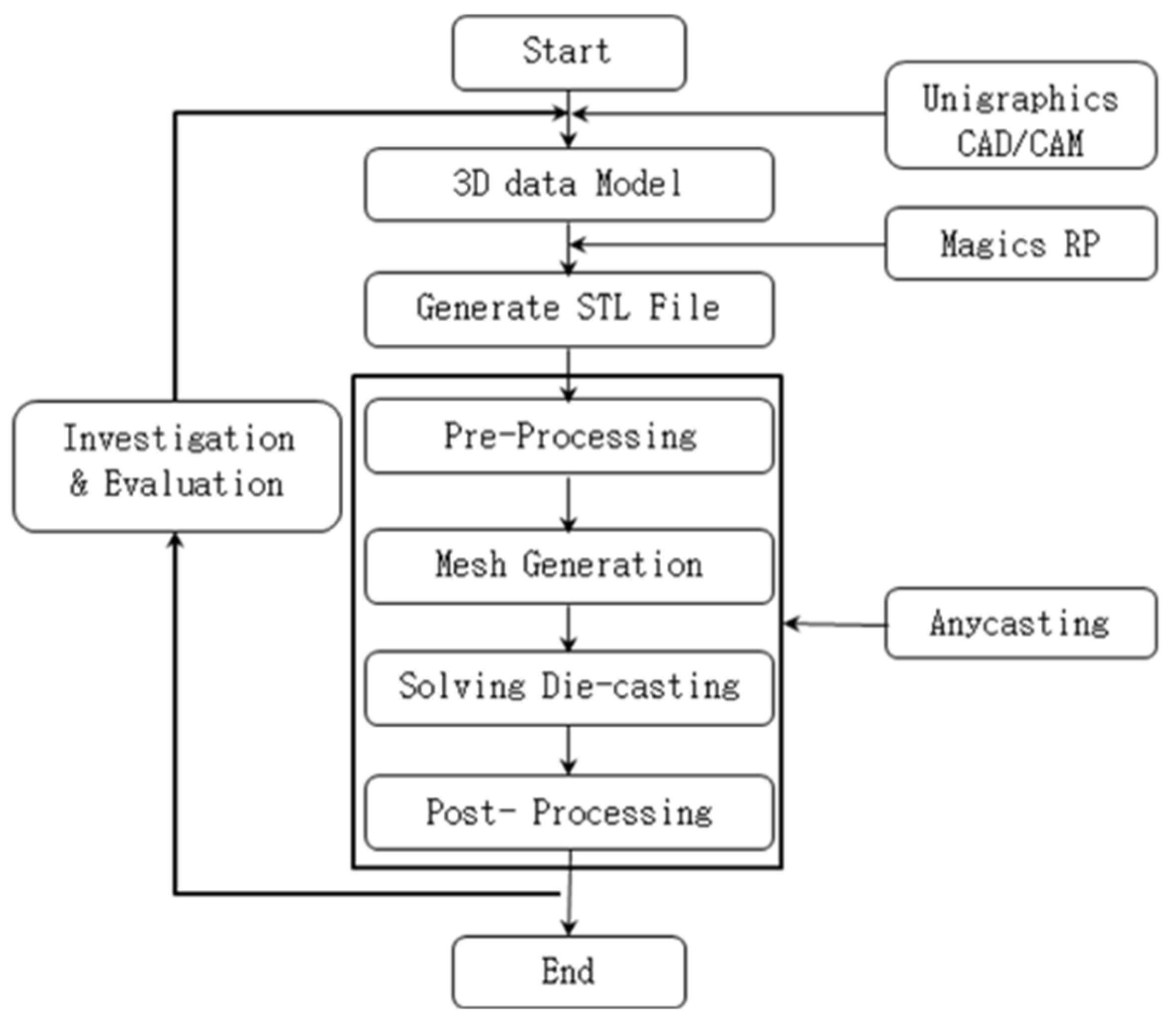




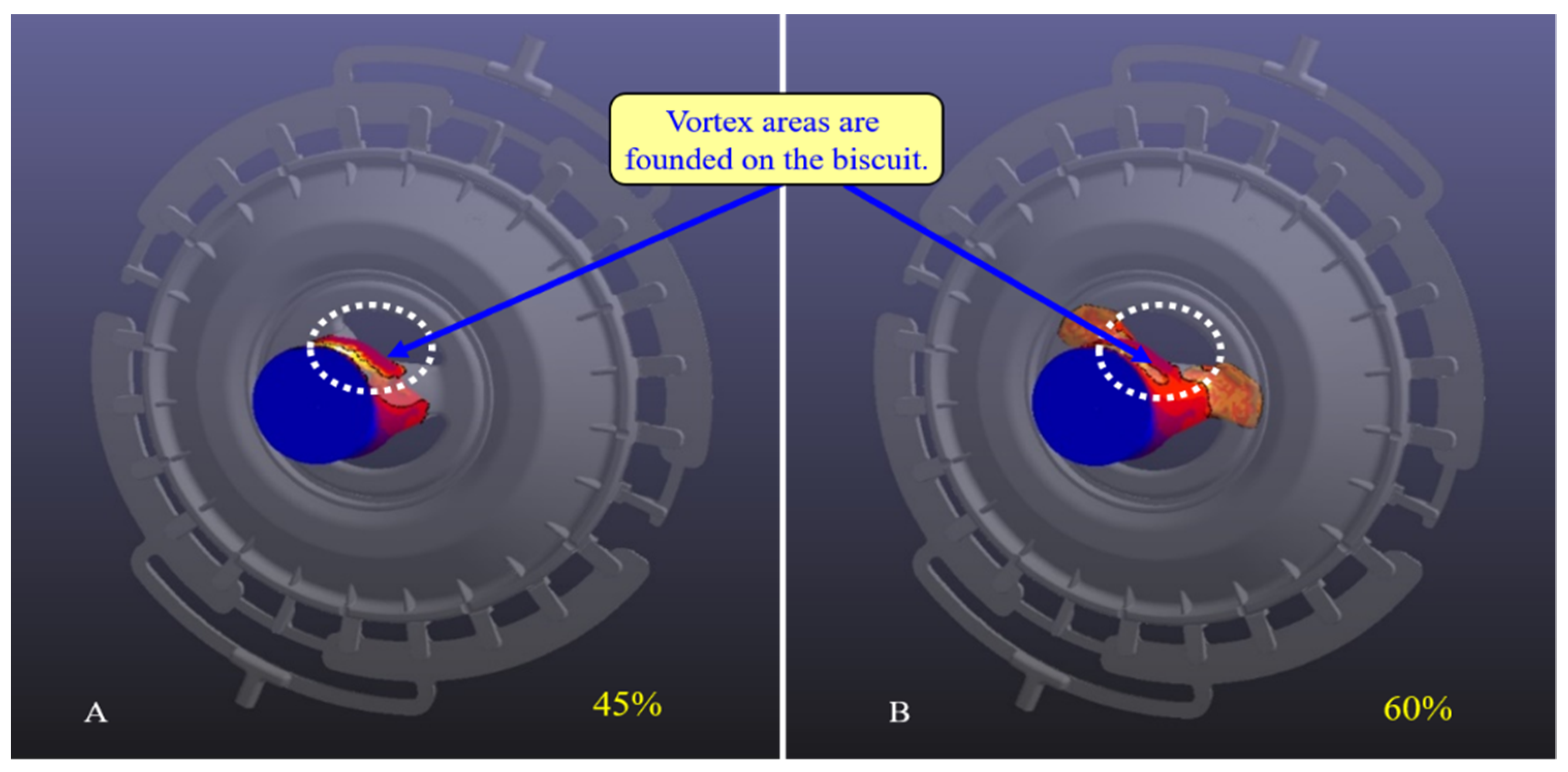

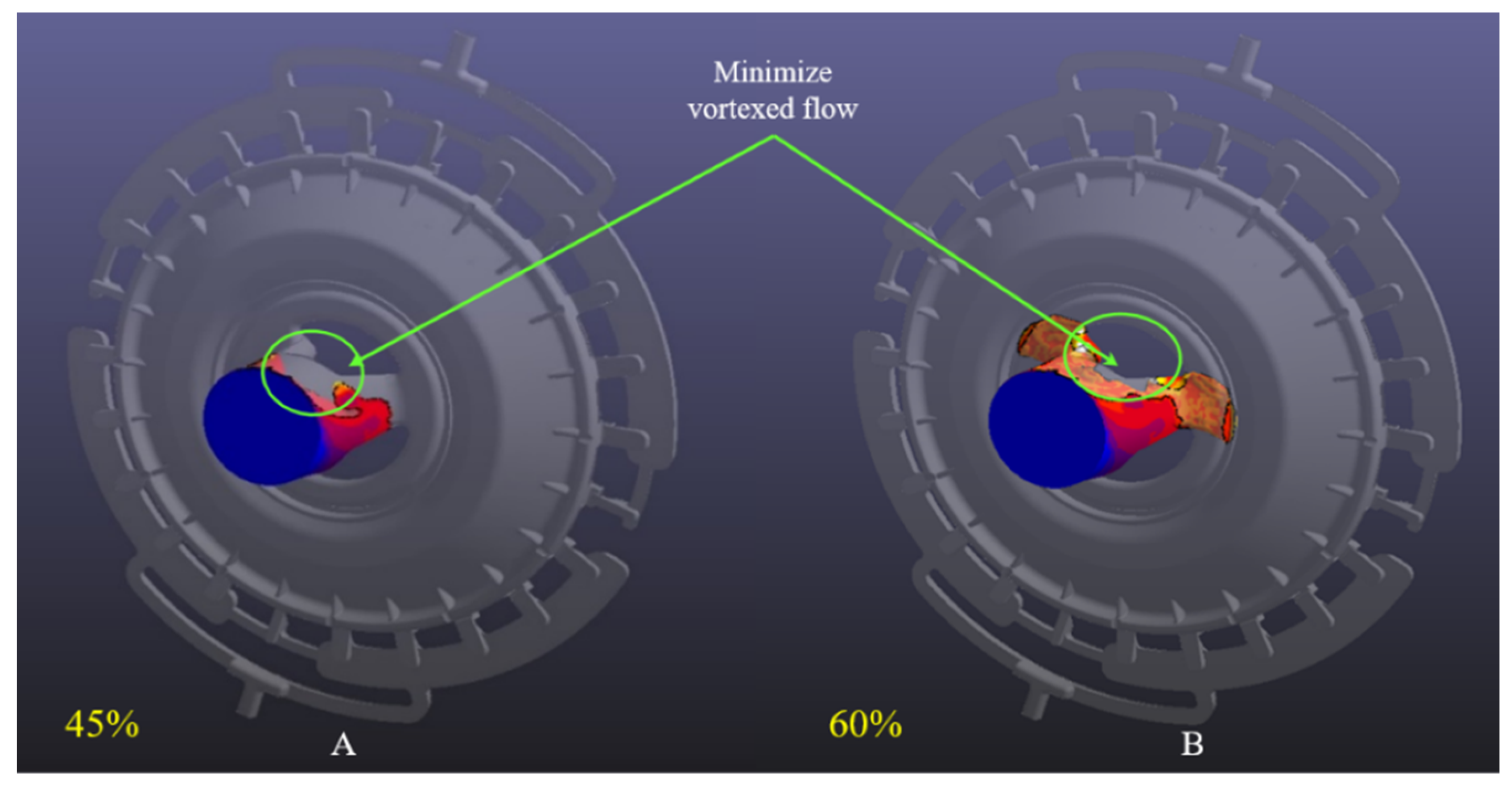

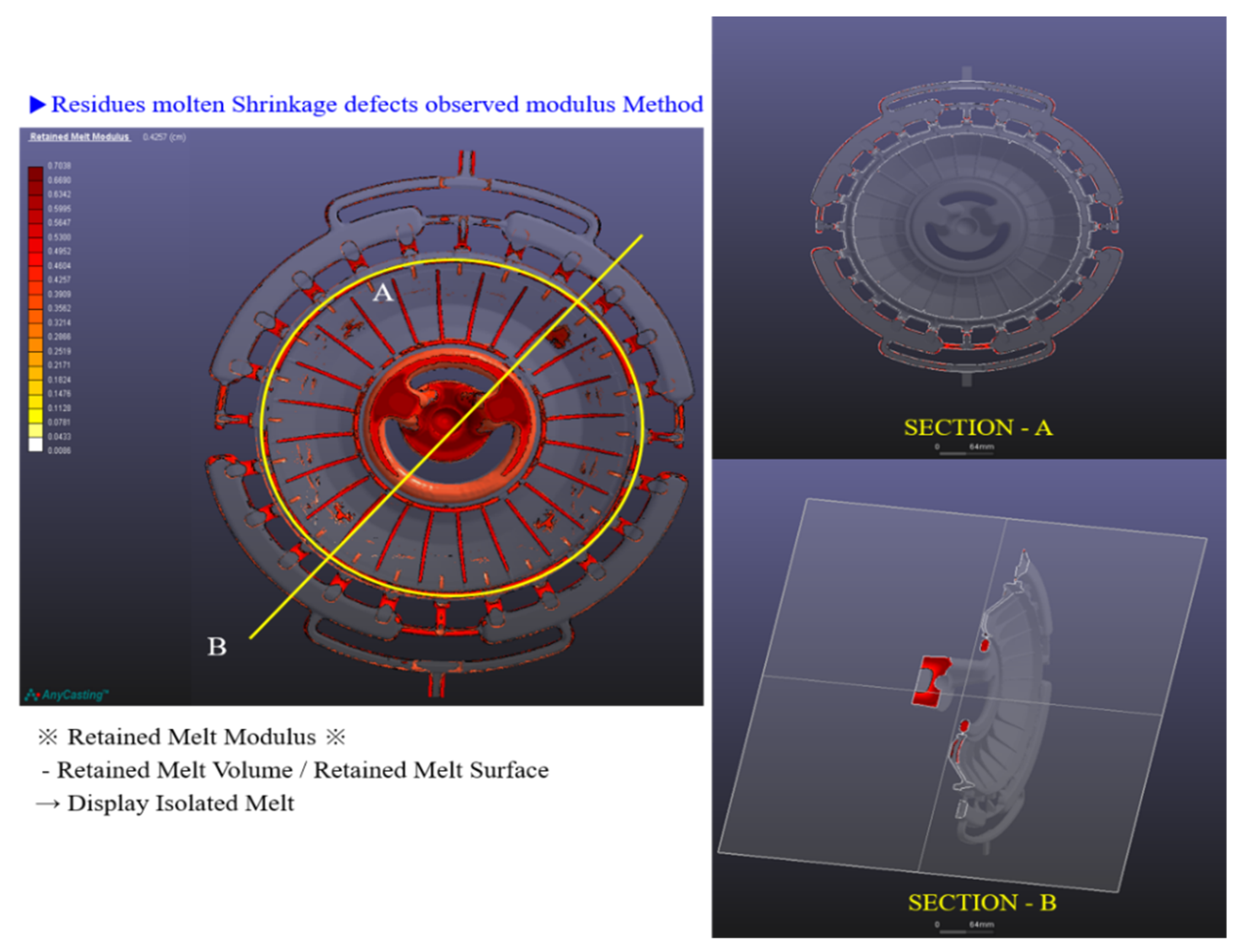
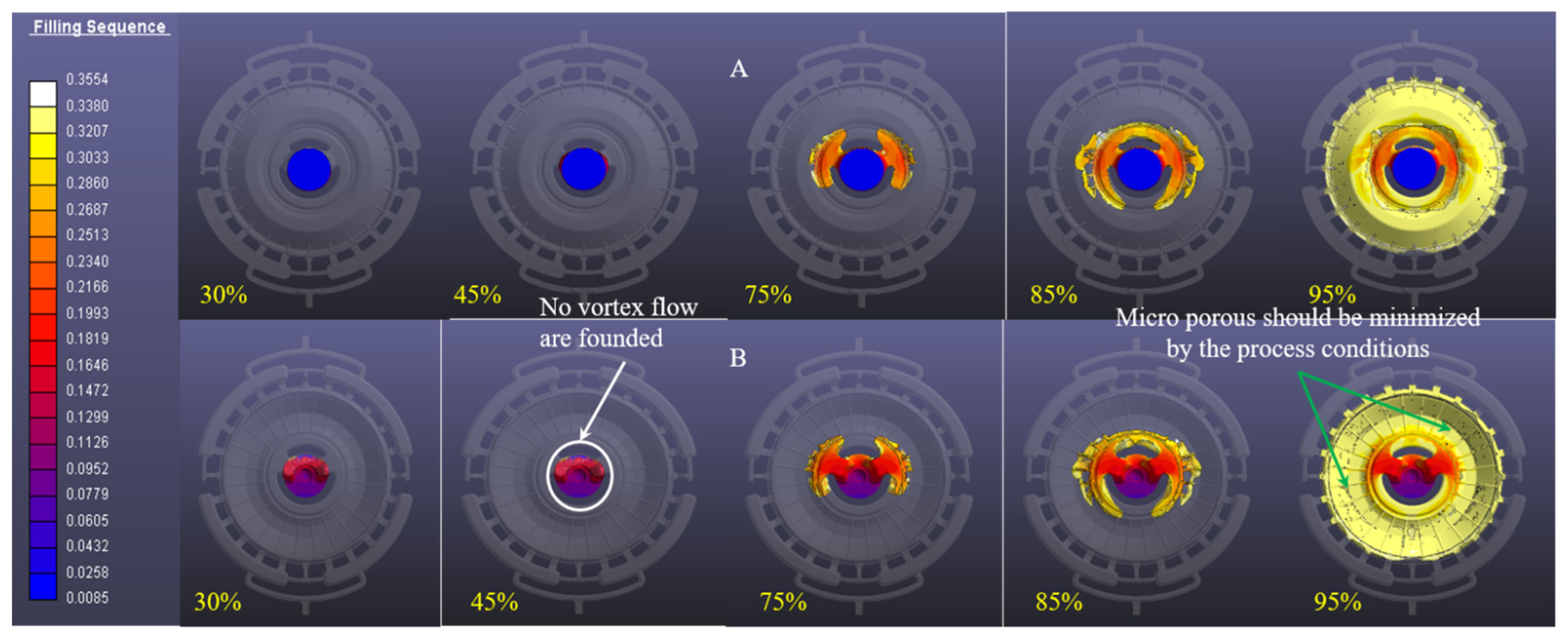
| Part | Mold | Plunger | |||
|---|---|---|---|---|---|
| Material | ACD12 | Material | SKD61 | Diameter | 70 mm |
| Liquidus Line | 580 °C | Initial Temperature | 200 °C | Slow Velocity | 0.20 m/s |
| Solidus Line | 515 °C | Casting Temperature | 280 °C | High Velocity | 6.00 m/s |
| Initial Temperature | 640 °C | Length | 510 mm | ||
| Weight for casting | 1087 g | ||||
| C | Si | Mn | P | S | Cr | Ni | Mo | V |
| 0.32–0.42 | 0.80–1.20 | <0.50 | <0.03 | <0.03 | 4.50–5.60 | 1.00–1.50 | 0.80–1.20 | |
| W | N | Cu | Co | Pb | B | Nb | Al | other |
Publisher’s Note: MDPI stays neutral with regard to jurisdictional claims in published maps and institutional affiliations. |
© 2021 by the author. Licensee MDPI, Basel, Switzerland. This article is an open access article distributed under the terms and conditions of the Creative Commons Attribution (CC BY) license (https://creativecommons.org/licenses/by/4.0/).
Share and Cite
Kwon, H.-K. Layout Design and Die Casting Using CAE Simulation for Household Appliances. Appl. Sci. 2021, 11, 10128. https://doi.org/10.3390/app112110128
Kwon H-K. Layout Design and Die Casting Using CAE Simulation for Household Appliances. Applied Sciences. 2021; 11(21):10128. https://doi.org/10.3390/app112110128
Chicago/Turabian StyleKwon, Hong-Kyu. 2021. "Layout Design and Die Casting Using CAE Simulation for Household Appliances" Applied Sciences 11, no. 21: 10128. https://doi.org/10.3390/app112110128
APA StyleKwon, H.-K. (2021). Layout Design and Die Casting Using CAE Simulation for Household Appliances. Applied Sciences, 11(21), 10128. https://doi.org/10.3390/app112110128





